Site URL Change
From Ron Daniels Rwdrc@aol.com
Hi Ken,
I am currently in the process of telling people where to find my new, improved web site.
My web site has been moved to www.rwdrc.com (Ron W Daniels). This site name should be easier to remember for people. In addition, the greater space will allow me to add a lot of non-commercial content to make the site more interesting to people who are not looking to buy an R/C kit.
Return to "What's In This Issue?"
Latest on Storch
From David Hipperson ritzi@corplink.com.au
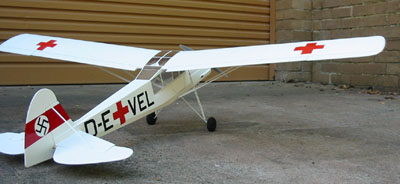
Dear Ken,
Following the interest shown after you published pictures of my first Storch, I thought I'd send you this. The Mk II version has been built and flown. I didn't even need any trim changes on the first flight.
To try something different, this one is running on 8 x 1100 HE cells driving an Aeronaut 6V 400 motor/gearbox at 2.07:1 ratio with an APC 9 X 6 electric prop. The flight time on this set up is around ten minutes with great handling. It has very slightly less power than the previous power arrangement, but it is more than adequate for us calm weather fliers.
Modifications other than the power set up consist of a revised wing section, a "C" type cabin (no machine gun position), and some slight structural changes. Oh yes, this one is covered in white Polytex, which increased the weight, by about one ounce.
I believe that the perfect power pack would be a geared 480 on eight cells or the equivalent in Li-Poly. I hope you like.
I now have to clean up the drawings, finish text and get photos together for forwarding to RCM&E who are proposing to publish later this year.
Regards,
David Hipperson
Return to "What's In This Issue?"
Another X-250 Ready to Go
From Don Mrozowicz wa3itz@penn.com
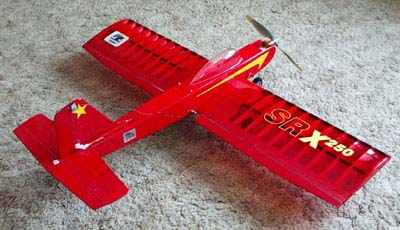
I finally finished it and have it ready to fly. Just need to melt 12" of snow.
This is the SR-X250 all electric, brush geared motor 9x6 prop 3-1500ma. LI-PO cell pack. RTF weight 23 oz. Should fly, I hope, maybe. Talk to you later.
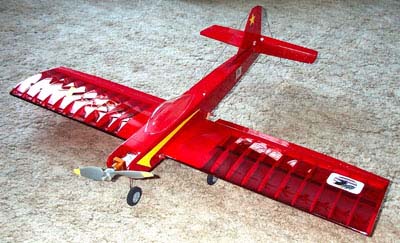
Addendum by Ken Myers
I've recently received several inquiries as to how mine flies. While this information was in the Ampeers following my online review, I'd never added it to my review on the site.
This is my always take to the field plane. I love the way it flies. It is a lot of fun, and not hard to fly. It goes where you point it, and just is a joy every time IÕm on the sticks. The only thing I can't get it to do is outside maneuvers. It just refuses to do an outside loop. I highly recommend this plane as an "aileron trainer." Both photos are of DonÕs plane. You can read my full review on the EFO Web site.
Return to "What's In This Issue?"
Li-Po Batteries
From: Dick Corby sales@altacom.us

Hi Ken:
Just a few lines to give you some idea about my experience with Lo-Po batteries.
I have been flying a Astro Viking (Image attached) since about 1998, and it has been a great airplane. Powered by a Mega Motor 05 (Car motor) and using a belt drive on 6 to 8 1700 to 2000 Ni-cad cells. It drew a steady 18-20 amps swinging an 11x7.5 prop.
Usually, if there were thermals, I could get in the range of 20-30 minute flights. But on a day with no thermals, and having to use power for the entire flight, I was lucky to get a 10-minute flight. Especially on calm days, the plane flew for a lot less time than I liked.
I read about and did my due diligence (and spent some cash) and got a Kokum Flight pack. 2S3P (2 in series and 3 in parallel) for 4500 mAh pack capable of 8C discharge. I bought their (Kokum) ESC, and an Astro Flight Li-Po Charger. I realized a 7 ounce reduction in weight, having gone from the Futaba receiver with built in ESC to a regular Hitec 5-channel receiver. I changed the prop to an 11x6. The batteries showed no sign of heating during charge.
Today I flew the new system for the first time. The first flight, in calm air, was in excess of 20 minutes, landed with power to spare. The second flight (flown till the pack shut down) was in excess of 30 minutes, also in relative calm conditions. I couldn't find any thermals at all. This pack flew at half throttle almost the entire flight both times, probably assisted by the weight loss. After both flights, the batteries were just barely warm.
So my conclusions are that Li-Po is what we were waiting for. We can stay up as long as the gas guys, with moderate throttle control. Granted, the Li-Po systems are rather pricey, but with care, should outlast Ni-cads without replacement. In the long run their estimated life is 600 cycles. In time, perhaps, the price will go down as the demand increases.
With multiple packs, the time to wait for charging between flights is not going to be as prohibitive as some have indicated. As it is, if you fly Ni-cads, you still are waiting for charge, even with multiple packs, one charging, one cooling and one ready to fly has been my practice. If I can fly Li-Po for 20-30 minutes, and not have to wait for cooling, I see no prohibitive wait time to speak of.
My next change is on my twin New Era. I'll let you know how that goes when I get it up and running.
Thanks for your info and experience with Li-Po cells in your Viking. I had a Viking (now owned by Richard Utkan) with an AF 05G and Jomar ESC. It used a 7-cell Sanyo 1200SCR pack and consistently got over 15 minutes of flight time in dead air. While the Li-Po cells have certainly added to your flight time, a really major change was the from the low-rate Futaba built-in ESC to your high efficiency stand-alone ESC. Altogether, you made two great improvements and have increased the joy of flying a great airframe design. For those interested, this airframe is still available from Models of Yesteryear. KM
Return to "What's In This Issue?"
Upcoming TRC 04 Electric Fly In
From: Wendall Hubbardgwhtoo@charter.net
APRIL 24 - Sherman, TX (C) Texoma R/C Electric Fly -In Site: Club Field, Sherman, TX Wendell Hubbard CD, 7924 Cold Shire Court, North Richland Hills, TX 76108 Phone:817-777-8230(day), 817-485-1498(eve) Sponsor: Texoma R/C Modelers #267 The fourth annual TRC Electric Fly-In. This is a Fly-In for all electric powered aircraft. RV's welcome. Lunch provided for pilots. Event web site: www.texomarc.org
We had 30 pilots last year and hope for a bigger turn out this year.
Upcoming Southeast Electric Flight Festival 2004
From Jeff Meyers jsmeyers@earthlink.net
We are will be hosting the Southeast Electric Flight Festival again this June in Americus, GA. The dates are June 17-20, 2004 (Thursday, Friday, Saturday, Sunday)
Flying from sunrise to dark and beyond if you have lights
We have added an additional day to the event...so now it is 4 days. There will be tons of open flying, LMR contest on Thursday, Zagi Combat and "The World Championship Soarstar Pylon Races". We are expecting a large turnout of both pilots and manufacturers.
Factory demo flights are going to be something to see...lots of new aircraft and technologies will be released at the event.
Here's a link to the event website. www.koolflightsystems.com/seff.htm
Return to "What's In This Issue?"
CA-Proof Plastic Plans Covering Material
From Gary Wright garyw3@yahoo.com
I noticed at the beginning of the Ampeer (Jan. '04 KM), the mentioning of "stick" structures sticking to waxed paper. That was always a huge annoyance to me, and I build a lot of "stick" type structure into my planes, so I had to find an alternative. I've tried the plans protectors that places sell (MonoKote¨ backing I think, not sure), and various brands of waxed paper. I saw a friend building a stick tail structure on some kind of very thin plastic, and when he lifted it up, it "popped" off without a trace of the plastic sticking. The magic plastic was dry cleaner bags. He saves all the bags from dry cleaning and builds on it.
Afterwards, while throwing something in my garbage can at work, I noticed that the liners our cleaning service uses are extremely thin plastic, and it dawned on me to try it. Sure enough, it seems to be the same material as dry cleaner bagging. I asked the cleaning crew one night for some (I'm at work at odd hours due to the profession :) ), and they gave me a roll of it. It is about two inches diameter. As thin as this stuff is, it looks like almost a lifetime supply. Works wonderfully! No more waxed paper stuck to the structure that creates issues with sanding.
Thought this might be a useful tidbit of information either for you personally, and/or the Ampeer. I've tested by just dripping CA, thick and thin, onto the surface, and allowing it to cure. The CA pops right off without taking any of the plastic with it.
Regards,
Gary Wright
Return to "What's In This Issue?"
Wire & Connectors Matter/Field Soldering
By Ken Myers
Back in the late 80's Jeff Hauser and I were spending a lot of time at the flying field, flying electrics. There were many times that we were asked to give a seasoned glow R/C pilot a hand who was trying electric for the first time.
We'd look over their plane, and let them have a go at it. Usually, they were not as successful as the planes Jeff and I were flying. Then they'd ask us why. Usually they were trying to fly the then popular Great Plane's ElectriCub or the PT Electric. Tower Hobbies recommended a six-cell pack with these planes. We pointed out that they were using a not too great motor, too few cells, usually the wrong prop and the wrong connectors.
Once we started noticing the connector problem, we started carrying Sermos/Anderson Power Pole connectors and a Portasol butane soldering iron to the field with us. We had found out that by simply changing the connectors from the supplied Tamiya-type to the Sermos connectors, the plane became somewhat more "flyable." It really was an amazing difference for just a connector change.
We'd gotten our Portasols when they were sold under the Archer brand at Radio Shack, but I don't believe they carry them anymore. A search of the Internet for Portasol should find you a vendor. We used the supplied tip for connector work.
For many, many years I used the optional T3 tip for making up my battery packs, until I got my 40-watt iron and hammerhead tip. For a long time, I preferred my butane iron to any plug-in soldering iron. I still carry it in my flight box to this day. That is about 15+ years of service.
What brought on these thoughts was an article by Stefen Vorkoetter in the February 2004 Quiet Flyer magazine. His article is called, "What About the Wires?" and is a recommended read.
Believe it or not, changing the wire and connectors can change a sort of flyable plane into a flyable plane. Who'd a thunk it? Hope you did!
Return to "What's In This Issue?"
Push-E Cat Is Back
From: Darwin Garrison garrison@rc-aero.com
Hi Ken,
This message was posted to the eflight list on February 1, 2004. It thrilled me, as I am very happy that my favorite trainer is once again available. Please let any and all RC beginners know where they can get this good flying, durable kit. KM
Hi, Guys:
After a long hiatus and a false start at parting with my kit lines, I am currently taking limited direct orders for Push-E Cats as well as any of my other models. These kits will be built to order and shipped 7 to 10 days after payment is received. Production will probably be limited to no more than 16 a month for the foreseeable future.
Available right away will be the Push-E Cat V3a. Also, the Push-E Cat THL will also be available (thermal version Push-E Cat with a 72 inch wing and wooden tail). I will announce when the Twin Cat and Push-E Cat A (for aileron) are available. Also coming soon is the 'Lite' fuselage option with a wooden tail boom and streamlined cabin.
If you are interested, please feel free to contact me at garrison@rc-aero.com for a kit reservation and payment information.
Best regards,
Darwin Garrison
Return to "What's In This Issue?"
Inexpensive Wind Meter
From: Dave Behner dave_behner@hotmail.com
Hi Ken,
I really appreciate your work putting the Ampeer together each month!!! Great Newsletter !!!
I received a flyer from RadioShack several weeks ago, which contained a Digital Wind Gauge for $14.99. I was just able to pick one up today. Here are the specifications:
Radio Shack P/N: 63-1119
Size: 5 1/16 x 1 9/19 x 1 9/16
Weight: 3.5 oz without batteries, 5.2 oz with.
Operating Temperature: 14 F to 122 F
Accurate between 6 and 30 MPH (non variable or gusty)
Can determine direction within 30 degrees.
Display is LCD and backlit with a hold function.
Auto power off after 2 minutes
Has a built-in Red LED "flashlight"
Comparing it to the wind direction I can get from the Internet derived from a local school, they were the same. Considering up until now it would cost about $100 for such a portable tool as this. I think it is very reasonable for the flying field. It also indicated if the wind is less than 6 MPH with an L and greater than 30 with an H. Thought you might like to pass the this on to others.
Hope you have a Great flying season and again thanks for all your efforts in our hobby.
Dave Behner
Portland, Oregon
I went to the Radio Shack site and found this photo of the unit. Also, it lists for only $29.99, even if it's not on sale. KM
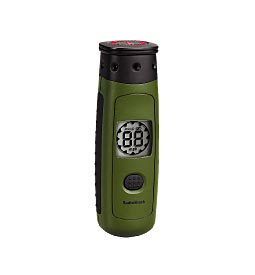 Return to "What's In This Issue?"
Return to "What's In This Issue?"
February 2004 EFO Meeting
Dave Stacer had another little wing to show off this month.
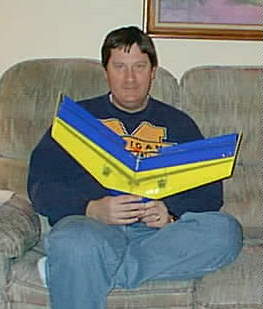
Norm Dmuchowski brought in his Slow Stik photo plane. He had just replaced the servo-controlled shutter of his Aiptek Mini Pencam with a SMT Backpack electronic switch. The electronic switch saves a lot of weight on this lightweight plane. It is available at http://home.att.net/~mechconsultant3/Index.htm . Some of the EFO members looked at that site to see how to modify the camera. You can either modify the camera yourself, or for a small fee, Roger, of SMT, will do it for you.
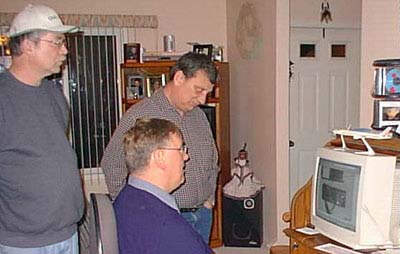
Ken showed his Radio Shack wind meter and advised club members who might want to purchase one to do it soon. He got his for $14.99 and feels that RS might be discontinuing the item.
Return to "What's In This Issue?"
GWS MC2002
From: Bernard Cawley bernard.e.cawley@boeing.com
Ken,
Re: the Easy Star review.......
I've been curious about that plane myself..... And my nearly-10-year-old daughter would be a good candidate for it - similar in configuration to the Push-E-Cat but much faster to get ready to fly. (Bernard has one now and there will be a review on the E-zone soon. KM) I've done the Sonic Liner and if the Easy Star goes together as well (and your review tells me it does) then it's a winner.
Concur on the timer charger. Too bad they had to cheap out there to compete with lesser airplanes on price.
I have direct experience with one of the chargers on your list - the GWS MC2002. This is an amazingly good charger for the price - handles 4-12 cells, up to 6A and has a soft enough peak detector to be safe for NiMH. The interface is just like current AF chargers: connect to power, connect to battery being charged, and dial in the charge current. I had two of them for awhile and kept one in my vehicle for impromptu flying support, but now that I'm running lithium in all my smaller planes. I sold one and just take my Electrocaddy with the Tx and some charged batteries with me most every time I go anywhere and I don't worry about recharging until I get home.
Oh, at a slightly higher price point, the WattAge PF-12 AC/DC charger is a good one, too. Only 2A max charge rate, but still up to 12 cells, and on AC as well as DC. I have one of these that lives on one of my work tables and gets used whenever I have a Tx to charge, as well as some smaller NiCds and NiMHs I use for static tests of motors and such.
Return to "What's In This Issue?"
Vinyl Lettering Supplier
From Jeff Kirsch jeff@signsbyyou.com
Our site is SignsByYou.com. We offer vinyl lettering and graphics that would be perfect for the model aircraft enthusiast. Everything we do is designed in a real time what you see is what you get environment. Thank you for your consideration. Our URL is www.signsbyyou.com.
Return to "What's In This Issue?"
Multiplex Condor
From Siegfried Kaltenbrunner kabrusi@utanet.at
Greetings from Austria. I've attached a photo from my Multiplex Condor and me.
Technical Data from the plane:
span 4,2 meter
weight about 6,5 kilogramm
motor Lehner brushless input power 840 watts
gear 6:1 reisenauer
prop 21x16"

Sigi & his Condor
Return to "What's In This Issue?"
Weights When Scaling Models Up and Down
From Mike mz34334@insightbb.com
I'm just reentering RC after a loooong hiatus. The last plane I flew had a Kraft KP-4a radio! I'm excited about electric and have just one question: Is there a rule of thumb numerical conversion factor for airframe weight when a set of plans is reduced in size, say from a 94" wing to 70" = 75%. I'm not sure whether the airframe weight should be reduced by (.75) squared or cubed, or somewhere between. The wing area follows (.75) squared = .56, but material thickness ought to be somewhat proportional as far as the next smaller thickness of balsa goes.
(I replied, but didn't really have an answer for him. Maybe some of you can help. He replied back with the following. KM)
Here's a thought. The data is out there, in the heads and records of guys like you. I'm sure you know of several cases of plans that were scaled up/down and the results as compared to the original weights.
Since I'm an engineer and applied mathematician, I'd be glad to fit the data into a fairly simple formula anyone could use.
All you need to do is gather and e-mail me the data.
Okay Mike, your idea is out there now. Let's see what kind of responses we get. KM
Return to "What's In This Issue?"
Reviewing the Reviews:
Jumping Jack Review, by Stephan Rojecki, Quiet Flyer, March 2004
By Ken Myers
I have been reviewing magazine reviews in the Ampeer, the monthly newsletter of the Electric Flyers Only, for a while now. This particular review caught my eye because of some of the statements of the author about this ARF.
Data from the FLITON Korean Web site: (note that the metric units were converted by Ken)
Wingspan: 1,000 mm (39.37 in.)
Length: 1,028 mm (40.47 in.)
Weight: 500 - 550 g (17.64 oz. Ð 19.40 oz.)
Wing Area: (none given)
Motor: 370 type
Radio: 4 Channel Radio
E.S.C.: 15 amp
Servos: 4 Micro Servos
Battery: 7-8 cell 600 mAh Ni-Cd Battery
FLITON's USA Web has some of the above data, but adds the following:
Recommends: Reinforcing Wing to Fuselage
"Designed specifically for 3D Pattern and Acrobatic enthusiasts."
The FLITON USA Web site most importantly omits the recommended motor. Neither Web site states the wing area. This is a significant number and should never be omitted in the information provided by the manufacturer/supplier. Stephan gave 272 sq.in. as the wing area in his table in Quiet Flyer, p55.
My power system data for this plane shows that for 3D performance, as the manufacturer suggests, the power system using a ferrite brushed motor would have to supply about 150 watts of input power, yielding about 95 watts out, at best. A 370 motor is only capable of absorbing and transferring, at most, about 90 watts while outputting only about 1/2 half that power. With the manufacturerÕs recommended motor and battery, the plane is incapable of hovering, and thus incapable of 3D aerobatics.
Stephan Rojecki realized that and chose a power system capable of providing the power for 3D aerobatics, as advertised by the manufacturer. He used a Hacker B20-18L with a 4:1 Maxon gearbox and a 3S1P Thunder Power Li-Poly 2100 mAh battery. Stephan stated that his setup drew 12 amps static with an APC 12x6 Thin Electric prop. That is approximately 133 watts of input power and about 113 watts out. According to my calculations, that is about the right number of watts out to allow this plane to stay in a hover and do 3D aerobatics.
HereÕs the rub. In his article "SPEED-400 UPGRADE", Quiet Flyer, March 2004, p.21, Stefen Vorkoetter states, "One very important thing to consider when upgrading a Speed-400 model - or any model, for that matter - to a more powerful system is whether or not the model's structure can handle the additional strain."
Here are a couple more statements from Stephan Rojecki's review of the Jumping Jack.
p.55 "The ailerons are tape-hinged on. The instructions only show hinge tape on the top side of the wing, but I hinged them top and bottom. This helps reduce the chance that the ailerons will flex up and down at the hinge lines, something that would eventually cause them to tear free."
p.57 "Just prior to the initial test flights, I talked with a couple of JJ owners/pilots. Unfortunately, both of their models had experienced catastrophic wing spar failures."
He ended the article with this quote, "Moreover, with a couple of minor structural changes, it will stand up to any type of 3-D piloting you can dish out."
One of the "minor" changes he recommended was removing the film from the bottom of the wing, adding carbon fiber rods to the top and bottom of the spars and refilming the bottom of the wing. To me that is NOT minor!
What's the problem?
The manufacturer designed a nice looking airplane, that if powered by the stock, recommended power system, would make a nice flying aerobatic plane. They advertised it incorrectly, and in so doing are providing a plane with built-in catastrophic wing failure, according the magazine review.
Stephan Rojecki did not do a stock review of the kit. He powered the kit to get 3D performance from it, thus over-stressing the designed structure and forcing him to modify an ARF to make it sound for the type of flying the manufacturer/supplier stated that it was capable of in its advertising.
Lastly, Quiet Flyer magazine should be taken to task for featuring this plane on their March 2004 cover. With the structural problems noted in their own review, as well as other problems in the review that I did not mention, and the misleading advertising by the manufacturer/supplier, this plane was not worthy of cover treatment.
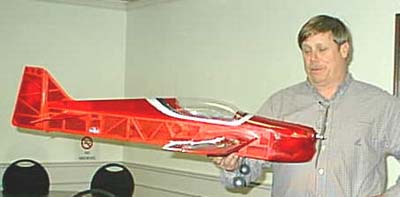
Larry Markey of Midwest RC Society with his Jumping Jack
Return to "What's In This Issue?"
New RC System Being Explored
Via: The Peregrine's Post
Internal Publication of the Ann Arbor Falcons
Volume 25 Number 2, February 2004
Don Skiff, Editor 734-998-1372, donskiff@comcast.net
1810 Cooley Ave., Ann Arbor, MI 48103
Warren Plohr reported on a recent meeting of the AMA Frequency Advisory Council in which a presentation was made for consideration of a new remote control system based on Frequency Hopping Spread Spectrum, on the 2.4 GHz band. Rather than limiting individual RC fliers to separate narrow frequency bands, the FHSS system allows a number of transmitters to operate on the same band at the same time. This would eliminate the frequency pin system widely used to prevent interference between radio links on the field. The system is already in use in military and commercial radio communication and control.
The ground-station and airborne stations both contain transmitters and receivers, so that the ground station receives confirmation of data received by the airborne unit. Instructions to the aircraft are sent on a rapidly-changing sequence of frequencies, increasing the security of the link and decreasing the likelihood of interference between RC systems. When a system is first powered up, it checks to see what other systems are in use, and chooses an unused sequence pattern.
If adopted, the system would be compatible with existing RC frequency use. Several issues must be addressed before such a system could be approved for use, some having to do with the 2.4 GHz part of the radio spectrum. The presenters told the Council that they will continue to test and explore.
Don requested more information from Warren for himself and Ken Myers. In an e-mail to both of us, Warren stated:
The following is also 'well known information' that can be published verbatim.
A small company known as Spectrum RC, has a working 16 channel RC system, that operates on the 2.4 GHz ISM Band, using a Frequency Hopping Spread Spectrum radio link. It is currently in development, and has been demonstrated around the country, but it is far from being a marketable RC system.
The prototype ground controller is built in a 1970 era Kraft Transmitter case. Only the antenna looks strange - - more like a 72 MHz rubber-duckie. It is called a ground controller because the Kraft case contains both a Transmitter and Receiver - - technically known as a Transceiver. The airborne box is not quite as big, but is also a Tranceiver.
Computers in both Transceivers communicate with each other over a relatively secure two-way Spread Spectrum radio link. It works very much like a home computer 802.11 WIFI system available at Best Buy. The ground transceiver's prime task is to transmit servo position information to the airborne transceiver. The airborne transceiver's prime task is to receive servo data, and then status the ground controller about it. A LCD on the front of the modified Kraft case displays the status.
The very nature of Spread Spectrum permits use of multiple RC systems at a flying site without using frequency pins. However, there is a limit on how many RC Systems can operate at the same site, as well as how close other flying sites can be. Spectrum RC is evaluating such limits.
Having three friends on the Frequency Advisory Committee, Jack Lemon (EFO), Warren Plohr (Ann Arbor Falcon) and Pete Waters (Kraft Midwest), I will try and provide more information on this possible future RC system. Please remember that this system is only in the very early stages of development and may or may not be something in our RC future. KM
Return to "What's In This Issue?"
Upcoming Cedar Rapids Meet
From Plenny Bates plennyb@mchsi.com
The Cedar Rapids Sky Hawks (Iowa) are hosting an E-fly August 7 - 8, 2004. For more information visit the Web site: 216.15.238.56/skyhawks/funfly
The web page will have minor modifications as they progress in the planning.
Return to "What's In This Issue?"
More on Li-Po Batteries
From: Dick Corby sales@altacom.us
Hi Ken:
Another stellar job on the newsletter.
I have a question for your Guys that are more into Li-Poly cells than I. I have recently been working with them, and find even though pricey, they do give a good return for the money in performance. Hopefully they will also turn out to cover their expense in flights per pack, which remains to be seen.
My question and concern is the constant information about their ability to "burst into flame." Not always said, but implied by comments about them. "Charge them outside the aircraft", "Make sure they are placed in a fireproof environment", "Have a fire extinguisher ready when charging" and so on. By the way, most of these admonitions are applicable to Ni-Cads if you read the manufacturers' warranties and information sheets. And I've never had a Ni-Cad pack explode or catch on fire either, in all the years I have been flying electric.
I have done these things, mainly to keep my home owner insurance company happy, and have never had any of the packs even get warm to the touch when charged at the 1C rate. I have an Astro Flight Li-Poly charger, and use only the recommended charge voltage. True it takes about an hour, but the longer flight time is worth it.
I also make sure that I have exceeded the mAh in packs for the plane involved. I am flying 2S-3P 1500 mAh hour packs in my Viking. This gives a total of 4500 mAh for the system. With the plane only using 10-12 amps in normal flight, (18 Amps at full high throttle) on landing the batteries are hardly warm to the touch and this is after a 15-20 minute flight.
So my question is what are others doing that can cause the batteries to "Burst into flame", or is it just the nature of the beast to do this under even the best of circumstances? I'm new to using this technology and would appreciate any input your guys can give me.
Dick Corby
EVERY instance I've read or heard about was through improper charging - human error. The person was using a charger that required a manual setting for the number of cells in the pack. The human forgot to change the cell count and for example, charged a 2-cell pack at a 3-cell setting. I know that when I start to play with Li-Poly, I'll be using the same charger you are. KM
Return to "What's In This Issue?"
Thoughts From Bernard Cawley
On Tony Turley and lithiums: Tony's being overly conservative. That said, the currently available packs being sold for replacing a 10-cell sub-C pack cost $200. But that pack flies the plane I used to get 7-10 minutes out of with P3000s for 25 minutes, and with more punch. It's coming. I am flying nothing but lithium in smaller planes any more and have kept a couple of Ni-Cd and NiMH packs smaller than sub-Cs only for motor testing purposes.
On the Easy Star: we just took delivery of one that my 10-year-old daughter is going to build. Looks like fun. I am in a quandary about a battery, though, as I don't know what I'm going to do with lithium and get the thing to balance. At the moment I'm thinking using pairs of 2s packs - K1500 or TP2100s - same batteries I'm using in my Sonic Liner. That should be good for 30-45 minutes on a charge. LOTS of training time.
On Kontronik and Great Planes: I'm REALLY wondering if they realize what they have. Reading through the thing from Heather Rose makes me think the answer is "sort of". Time will tell if this time GP gets it right or close to right...... remember the Kyosho Zero with the LeMans motor!
My most recent project was a one-day wonder (built on Saturday in between other stuff and flown Sunday and Monday and today) - a true cul-de-sac flyer - the Stevens Aero "DiddleBug". It's a sort of old-timer looking three-channel plane that weighs all of 2.7 ounces ready to fly, with three channels. Lots of info on the Ezone. Here's my thread on it: www.rcgroups.com/forums/showthread.php?s=&threadid=202688. It comes from www.stevensaero.com.
Return to "What's In This Issue?"
Upcoming April EFO Meeting Info
Our April meeting will be on Saturday the xx. It will be a flying meeting with MISS. We will meet at Camp Dearborn in Milford, MI at about 10 a.m. Fly, have lunch, fly and have a lot of fun. Camp Dearborn is on the west side of Milford on GM Road. All AMA members flying electrics and gliders are welcome to join us.
Return to "What's In This Issue?"
| 









